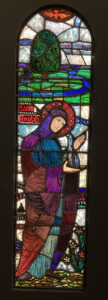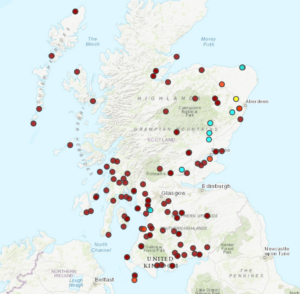
On 1st February last month, celebrations began in Ireland in relation to St Brigit of Kildare, since that is the likely 1500th anniversary of her death.[1] This blog was prompted by a conundrum: there is a minor but persistent modern tradition associating St Brigit with Iona, which will be explored in a second blog; however this is contrasted with the complete absence of any evidence for the cult of Brigit on Iona before the period of the Celtic Revival around 1900. In this first blog, I discuss the plentiful evidence that St Brigit was well known in the Hebrides and Argyll in the middle ages, and consider what the apparent absence of her cult from Iona, and certainly from Iona place-names, might mean.[2]
St Brigit founded the highly important monastery of Kildare, in Co. Kildare, Ireland, sometime in the late 5th century. We rightly celebrate Adomnán of Iona’s Life of St Columba as a triumph of hagiographical writing from the seventh century; Brigit, however, may have been “a saint with three lives” by 700, as one article title suggests.[3] In Ireland she was early on celebrated as one the “two columns of the Kingdom [of Heaven]”, the other being St Patrick;[4] later on Columba would join them as the third of the three chief saints of Ireland, and the Gaelic world more widely.
Despite the clear historical prominence of St Brigit and her monastery, recent years have seen a tendency to explain her significance by reference to a putative pre-Christian goddess somehow transformed into a saint, a saint who never was. Although this idea is currently very prevalent, the evidence is actually quite poor, and in Women’s History Month we might want to reflect on the drivers behind diminishing the importance of an historical woman by saying that she was really just the memory of a goddess. In a recent article, Dr Elva Johnston of University College Dublin writes of the need to “make Brigit real” again.[5] There is also an excellent discussion of Brigit, her historical background, and the problem of these recent ideas about her, in a podcast by Dr Niamh Wycherley of Maynooth University, in conversation with Prof. Catherine McKenna of Harvard: it’s well worth a listen here.
Although Brigit is never claimed in medieval tradition to have set foot in Scotland (though see below about her successor), she was clearly held in high regard here in the middle ages. Large numbers of place-names testify to this, in the forms of names like Cille Bhrìghde, Kilbride or, in south-west Scotland, Kirkbride.[6] After the Virgin Mary, she seems to be the saint most represented in place-names in Scotland. The why and when of this is not completely clear, but her cult’s presence in south-west Scotland, in Gaelic place-names, perhaps holds a clue in that Gaelic is not likely to have had much purchase in that area until after around 900, and, failing any better evidence, we might want to think of the founding of many of the churches which bear her name as belong to the period 900-1200 or so.[7] They were likely mostly there by the later middle ages, when our evidence becomes more plentiful, recording various of these names in ecclesiastical documents and the like. In addition, as with other saints, not all dedications to St Brigit are preserved in place-names. For instance, Dr Alasdair Whyte discusses the presence of a dedication to St Brigit in Gleann Cainnir~Glen Cannel in Torosay, Mull, where it seems to exist alongside the commemoration of another female saint, and its wider significance.[8]

Elsewhere in Scotland her cult may be even older. A 9th-century legend of the founding of the monastery of Abernethy describes its dedication “to God and St Brigit”, by Brigit’s immediate successor as abbess of Kildare, Darlugdach. If the legend were factually correct, this would bring her cult in eastern Scotland way back into the early 6th century, which seems somewhat implausible. Nonetheless, Abernethy was dedicated to Brigit and must have been associated with her since the 9th century at the latest. Interestingly, an abbot of Iona in the 9th century was also abbot of Kildare. In 865, the Annals of Ulster tell us “Cellach son of Ailill, abbot of Kildare and Iona fell asleep [i.e., died] in the country of the Picts” (Cellach m. Ailella, abbas Cille Daro et abbas Ia, dormiuit in regione Pictorum). Perhaps this individual had something to do with the Abernethy legend.[9]
Given this ubiquity, we might perhaps expect to find some trace of her in Iona’s Namescape. However, Brigit has left no discernible trace in Iona’s place-names, and there is no other sign of her elsewhere in association with the island until the Celtic Revival, as I noted earlier. We have plenty of other saints commemorated—Cainnech, Ciarán, Adomnán, Odrán; and universal saints like Mary, Martin, and John; and we may have another female saint, Rónnat, masquerading as a male saint Rónán, in the name of Teampull Rònain as discussed in a previous blog. I have suggested elsewhere that churches dedicated to Brigit seem often to be secondary or ancillary, often not the main parish church in areas; and have speculated on whether they had some sort of function similar to lady chapels in medieval England (see note 5 below). A tradition stretching back to the early middle ages aligns Brigit with the Virgin Mary, even going so far as seeing her as the ‘Mary of the Gael’, and describing her (extraordinarily) as máthir Ísu (“the mother of Jesus”).[10]
Perhaps the strong and long-standing presence of the cult of the Virgin Mary on the island (discussed in a recent blog here) has most to do with her absence? And perhaps the culting of Adomnán’s mother, Rónnat (if we are right in seeing her in Teampull Rònain) also filled a niche which Brigit might otherwise have occupied? In a very interesting article, Prof. Thomas Charles-Edwards discusses the “constituencies” of saints. Of Brigit, he notes: “Brigit, however, stood apart from kings, not just because she was a woman, but because, as a former slave-girl, she could speak for those who suffered at the hands of the powerful.”[11] (Charles-Edwards 2017, 83). Just as her standing as a prime female saint may have been eclipsed on Iona by others, perhaps we might also see Iona’s own Adomnán as potentially fulfilling Brigit’s role of “protector of the weak” in the early middle ages, given his framing of the “Law of the Innocents”, intended to protect non-combatants, in 697. In other words, maybe the lack of a cult of Brigit was because other saints were already available on Iona, serving her usual constituencies?
Ultimately, assessing an absence is a somewhat fruitless task: it is easier to consider why a saint is somewhere than why she isn’t. Nonetheless, in this year, and in Women’s History Month, it seemed worthwhile to look more closely at this particular absence. A second blog will explore the introduction of Brigit into the Iona landscape by writers and artists during the period of the Celtic Revival and later.
NOTES
[1] See for instance the Brigid 1500 site: https://brigid1500.ie/aboutbrigid1500/ ; a new public holiday around St Brigit’s day is now held in Ireland, see: https://www.irishtimes.com/ireland/2023/01/16/festival-to-honour-the-1500th-anniversary-of-st-brigid-to-take-place-ahead-of-new-public-holiday/
[2] For a discussion of her cult in relation to the Outer Hebrides, see the entry on Brìde, Brigit on Eòlas nan Naomh: Early Christianity on Uist https://uistsaints.co.uk/saints/bride/
[3] Kim McCone, “Brigit in the seventh century: a saint with three lives?”, Peritia 1 (1982), 107-45.
[4] In the poem Brigit bé bíthmaith “Brigit, ever excellent woman”, edited and translated by Whitley Stokes and John Strachan, Thesaurus Palaeohibernicus vol. 2 (Cambridge, 1903), 325-6: https://archive.org/details/thesauruspalaeoh02stokuoft/page/324/mode/2up?view=theater Also see for links to a recording of this poem. https://uistsaints.co.uk/saints/bride/ Also see for links to a recording of this poem.
[5] Elva Johnston, “Making St Brigit real in the early middle ages”, Proceedings of the Royal Irish Academy 124C (2024), 1-26: https://doi.org/10.1353/ria.0.a918428
[6] See the Commemorations of Saints in Scottish Place-Names web-resource, here: https://saintsplaces.gla.ac.uk/saint.php?id=396
[7] I have discussed this in more detail in an article: “Saints in the Scottish Landscape”, Proceedings of the Harvard Celtic Colloquium 33, 2013 (2014), 1-34.
[8] Alasdair Whyte, “Settlement-names and society: analysis of the medieval districts of Forsa and Moloros in the parish of Torosay, Mull”, (PhD thesis, University of Glasgow, 2017), 95-96 [available at: https://theses.gla.ac.uk/8224/ ]
[9] I explore this idea further in a note “Cellach mac Ailella and the Pictish king-list”, forthcoming in Scottish Historical Review.
[10] See the poem mentioned in fn 4, and also: Diane Auslander, “Gendering the Vita Prima: An Examination of St. Brigid’s Role as ‘Mary of the Gael’,”Proceedings of the Harvard Celtic Colloquium 20/21 (2001), 187-202; and Gilbert Márkus, “Do Macc Máire: Motherin God”, Spirituality 9, no. 50 (2003), 277-81.
[11] Thomas Charles-Edwards, “Early Irish saints’ cults and their constituencies”, Ériu 54 (2017), 79-102, at 83.
